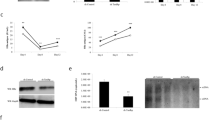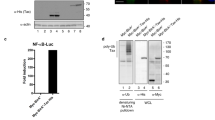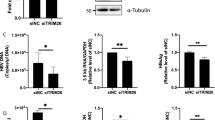Abstract
The stability of Myc oncoprotein is regulated by Skp/cullin/F-box (SCF) ubiquitin E3 ligase, in particular, via either SCFSkp2 or SCFFbw7 ubiquitin E3 ligases. An earlier study has shown that hepatitis B virus X protein (HBx) augments Myc stability via a mechanism involving the inhibition of Myc ubiquitination. However, the underlying mechanism by which HBx inhibits Myc ubiquitination remained to be elucidated. Moreover, to what extent HBx-mediated Myc stabilization contributes to viral oncogenesis is unknown. First, we corroborated the physiological significance of HBx-mediated Myc stabilization in HBV-replicating cells by demonstrating that (1) the elevation of Myc level in a HBV-replicating HepG2.2.15 cell compared to parental cells; (2) HBx-mediated Myc stabilization in a HBV replicon transfected cells; and (3) the inhibition of Myc ubiquitination by HBx in a HBV replicon transfected cells. Then, the molecular interaction between HBx and Myc protein was revealed via coimmunoprecipitation and immunofluorescence experiments. Subsequent analysis indicated that HBx stabilizes Myc oncoprotein by blocking Skp2, as opposed to Fbw7, -mediated Myc ubiquitination. Next, we defined the Myc-binding region to four residues (VFVL) near the C-terminus of HBx polypeptide. An HBx variant with mutated VFVL consistently failed to not only interact with Myc but also suppress Myc ubiquitination. Importantly, the VFVL mutant lost the ability to transform NIH3T3 cells in concert with Ras, implying that the HBx–Myc interaction is critical for viral oncogenesis. Consistently, immunohistochemistry of liver biopsies revealed that Myc protein is elevated in HBV-infected tissues. We concluded that HBx stabilizes Myc oncoprotein by inhibiting SCFSkp2 ubiquitin E3 ligase-mediated Myc ubiquitination, and the HBx-mediated Myc stabilization greatly contributes to viral oncogenesis.
This is a preview of subscription content, access via your institution
Access options
Subscribe to this journal
Receive 50 print issues and online access
$259.00 per year
only $5.18 per issue
Buy this article
- Purchase on Springer Link
- Instant access to full article PDF
Prices may be subject to local taxes which are calculated during checkout









Similar content being viewed by others
References
El-Serag HB . Epidemiology of viral hepatitis and hepatocellular carcinoma. Gastroenterology 2012; 142: e1261.
Neuveut C, Wei Y, Buendia MA . Mechanisms of HBV-related hepatocarcinogenesis. J Hepatol 2010; 52: 594–604.
Benhenda S, Cougot D, Buendia MA, Neuveut C . Hepatitis B virus X protein molecular functions and its role in virus life cycle and pathogenesis. Adv Cancer Res 2009; 103: 75–109.
Ng SA, Lee C . Hepatitis B virus X gene and hepatocarcinogenesis. J Gastroenterol 2011; 46: 974–990.
Murakami S . Hepatitis B virus X protein: a multifunctional viral regulator. J Gastroenterol 2001; 36: 651–660.
Bouchard MJ, Schneider RJ . The enigmatic X gene of hepatitis B virus. J Virol 2004; 78: 12725–12734.
Slagle BL, Andrisani OM, Bouchard MJ, Lee CG, Ou JH, Siddiqui A . Technical standards for hepatitis B virus X protein (HBx) research. Hepatology 2015; 61: 1416–1424.
Kim CM, Koike K, Saito I, Miyamura T, Jay G . HBx gene of hepatitis B virus induces liver cancer in transgenic mice. Nature 1991; 351: 317–320.
Lee TH, Finegold MJ, Shen RF, DeMayo JL, Woo SL, Butel JS . Hepatitis B virus transactivator X protein is not tumorigenic in transgenic mice. J Virol 1990; 64: 5939–5947.
Reifenberg K, Lohler J, Pudollek HP, Schmitteckert E, Spindler G, Kock J et al. Long-term expression of the hepatitis B virus core-e- and X-proteins does not cause pathologic changes in transgenic mice. J Hepatol 1997; 26: 119–130.
Madden CR, Finegold MJ, Slagle BL . Hepatitis B virus X protein acts as a tumor promoter in development of diethylnitrosamine-induced preneoplastic lesions. J Virol 2001; 75: 3851–3858.
Slagle BL, Lee TH, Medina D, Finegold MJ, Butel JS . Increased sensitivity to the hepatocarcinogen diethylnitrosamine in transgenic mice carrying the hepatitis B virus X gene. Mol Carcinog 1996; 15: 261–269.
Terradillos O, Billet O, Renard CA, Levy R, Molina T, Briand P et al. The hepatitis B virus X gene potentiates c-myc-induced liver oncogenesis in transgenic mice. Oncogene 1997; 14: 395–404.
Lakhtakia R, Kumar V, Reddi H, Mathur M, Dattagupta S, Panda SK . Hepatocellular carcinoma in a hepatitis B 'x' transgenic mouse model: a sequential pathological evaluation. J Gastroenterol Hepatol 2003; 18: 80–91.
Kim YC, Song KS, Yoon G, Nam MJ, Ryu WS . Activated ras oncogene collaborates with HBx gene of hepatitis B virus to transform cells by suppressing HBx-mediated apoptosis. Oncogene 2001; 20: 16–23.
Oishi N, Shilagardi K, Nakamoto Y, Honda M, Kaneko S, Murakami S . Hepatitis B virus X protein overcomes oncogenic RAS-induced senescence in human immortalized cells. Cancer Sci 2007; 98: 1540–1548.
Petroski MD, Deshaies RJ . Function and regulation of cullin-RING ubiquitin ligases. Nat Rev Mol Cell Biol 2005; 6: 9–20.
Flinn EM, Busch CM, Wright AP . myc boxes, which are conserved in myc family proteins, are signals for protein degradation via the proteasome. Mol Cell Biol 1998; 18: 5961–5969.
Salghetti SE, Kim SY, Tansey WP . Destruction of Myc by ubiquitin-mediated proteolysis: cancer-associated and transforming mutations stabilize Myc. EMBO J 1999; 18: 717–726.
Kim SY, Herbst A, Tworkowski KA, Salghetti SE, Tansey WP . Skp2 regulates Myc protein stability and activity. Mol Cell 2003; 11: 1177–1188.
von der Lehr N, Johansson S, Wu S, Bahram F, Castell A, Cetinkaya C et al. The F-box protein Skp2 participates in c-Myc proteosomal degradation and acts as a cofactor for c-Myc-regulated transcription. Mol Cell 2003; 11: 1189–1200.
Welcker M, Orian A, Jin J, Grim JE, Harper JW, Eisenman RN et al. The Fbw7 tumor suppressor regulates glycogen synthase kinase 3 phosphorylation-dependent c-Myc protein degradation. Proc Natl Acad Sci USA 2004; 101: 9085–9090.
Choi SH, Wright JB, Gerber SA, Cole MD . Myc protein is stabilized by suppression of a novel E3 ligase complex in cancer cells. Genes Dev 2010; 24: 1236–1241.
Li T, Robert EI, van Breugel PC, Strubin M, Zheng N . A promiscuous alpha-helical motif anchors viral hijackers and substrate receptors to the CUL4-DDB1 ubiquitin ligase machinery. Nat Struct Mol Biol 2010; 17: 105–111.
Kalra N, Kumar V . The X protein of hepatitis B virus binds to the F box protein Skp2 and inhibits the ubiquitination and proteasomal degradation of c-Myc. FEBS Lett 2006; 580: 431–436.
Hu Z, Zhang Z, Doo E, Coux O, Goldberg AL, Liang TJ . Hepatitis B virus X protein is both a substrate and a potential inhibitor of the proteasome complex. J Virol 1999; 73: 7231–7240.
Cha MY, Ryu DK, Jung HS, Chang HE, Ryu WS . Stimulation of hepatitis B virus genome replication by HBx is linked to both nuclear and cytoplasmic HBx expression. J Gen Virol 2009; 90: 978–986.
Kim S, Kim HY, Lee S, Kim SW, Sohn S, Kim K et al. Hepatitis B virus x protein induces perinuclear mitochondrial clustering in microtubule- and dynein-dependent manners. J Virol 2007; 81: 1714–1726.
Tu H, Bonura C, Giannini C, Mouly H, Soussan P, Kew M et al. Biological impact of natural COOH-terminal deletions of hepatitis B virus X protein in hepatocellular carcinoma tissues. Cancer Res 2001; 61: 7803–7810.
Ma NF, Lau SH, Hu L, Xie D, Wu J, Yang J et al. COOH-terminal truncated HBV X protein plays key role in hepatocarcinogenesis. Clin Cancer Res 2008; 14: 5061–5068.
Sze KM, Chu GK, Lee JM, Ng IO . C-terminal truncated hepatitis B virus x protein is associated with metastasis and enhances invasiveness by C-Jun/matrix metalloproteinase protein 10 activation in hepatocellular carcinoma. Hepatology 2013; 57: 131–139.
Thomas LR, Tansey WP . Proteolytic control of the oncoprotein transcription factor Myc. Adv Cancer Res 2011; 110: 77–106.
Farazi PA, DePinho RA . Hepatocellular carcinoma pathogenesis: from genes to environment. Nat Rev Cancer 2006; 6: 674–687.
Thorgeirsson SS, Grisham JW . Molecular pathogenesis of human hepatocellular carcinoma. Nat Genet 2002; 31: 339–346.
Kaposi-Novak P, Libbrecht L, Woo HG, Lee YH, Sears NC, Coulouarn C et al. Central role of c-Myc during malignant conversion in human hepatocarcinogenesis. Cancer Res 2009; 69: 2775–2782.
Geng X, Huang C, Qin Y, McCombs JE, Yuan Q, Harry BL et al. Hepatitis B virus X protein targets Bcl-2 proteins to increase intracellular calcium, required for virus replication and cell death induction. Proc Natl Acad Sci USA 2012; 109: 18471–18476.
Kusunoki H, Tanaka T, Kohno T, Wakamatsu K, Hamaguchi I . Structural characterization of the BH3-like motif of hepatitis B virus X protein. Biochem Biophys Res Commun 2014; 450: 741–745.
Barry M, Fruh K . Viral modulators of cullin RING ubiquitin ligases: culling the host defense. Sci STKE 2006; 2006: pe21.
Bajaj BG, Murakami M, Cai Q, Verma SC, Lan K, Robertson ES . Epstein-Barr virus nuclear antigen 3C interacts with and enhances the stability of the c-Myc oncoprotein. J Virol 2008; 82: 4082–4090.
Baresova P, Pitha PM, Lubyova B . Kaposi sarcoma-associated herpesvirus vIRF-3 protein binds to F-box of Skp2 protein and acts as a regulator of c-Myc protein function and stability. J Biol Chem 2012; 287: 16199–16208.
Shachaf CM, Kopelman AM, Arvanitis C, Karlsson A, Beer S, Mandl S et al. MYC inactivation uncovers pluripotent differentiation and tumour dormancy in hepatocellular cancer. Nature 2004; 431: 1112–1117.
Ko C, Lee S, Windisch MP, Ryu WS . DDX3 DEAD-box RNA helicase is a host factor that restricts hepatitis B virus replication at the transcriptional level. J Virol 2014; 88: 13689–13698.
Wang H, Kim S, Ryu WS . DDX3 DEAD-box RNA helicase inhibits hepatitis B virus reverse transcription by incorporation into nucleocapsids. J Virol 2009; 83: 5815–5824.
Utku Y, Dehan E, Ouerfelli O, Piano F, Zuckermann RN, Pagano M et al. A peptidomimetic siRNA transfection reagent for highly effective gene silencing. Mol Biosyst 2006; 2: 312–317.
Kim S, Wang H, Ryu WS . Incorporation of eukaryotic translation initiation factor eIF4E into viral nucleocapsids via interaction with hepatitis B virus polymerase. J Virol 2010; 84: 52–58.
Wang H, Ryu WS . Hepatitis B virus polymerase blocks pattern recognition receptor signaling via interaction with DDX3: implications for immune evasion. PLoS Pathog 2010; 6: e1000986.
Gregory MA, Hann SR . c-Myc proteolysis by the ubiquitin-proteasome pathway: stabilization of c-Myc in Burkitt's lymphoma cells. Mol Cell Biol 2000; 20: 2423–2435.
Popov N, Wanzel M, Madiredjo M, Zhang D, Beijersbergen R, Bernards R et al. The ubiquitin-specific protease USP28 is required for MYC stability. Nat Cell Biol 2007; 9: 765–774.
Cho HS, Shimazu T, Toyokawa G, Daigo Y, Maehara Y, Hayami S et al. Enhanced HSP70 lysine methylation promotes proliferation of cancer cells through activation of aurora kinase B. Nat Commun 2012; 3: 1072.
Acknowledgements
This work was supported by a National Research Foundation of Korea (NRF) grant funded by the Korean government (MSIP; NRF-2012R1A2A2A01007811). SL and WK are fellowship awardee by BK21 PLUS program.
Author information
Authors and Affiliations
Corresponding author
Ethics declarations
Competing interests
The authors declare no conflict of interest.
Additional information
Supplementary Information accompanies this paper on the Oncogene website
Rights and permissions
About this article
Cite this article
Lee, S., Kim, W., Ko, C. et al. Hepatitis B virus X protein enhances Myc stability by inhibiting SCFSkp2 ubiquitin E3 ligase-mediated Myc ubiquitination and contributes to oncogenesis. Oncogene 35, 1857–1867 (2016). https://doi.org/10.1038/onc.2015.251
Received:
Revised:
Accepted:
Published:
Issue Date:
DOI: https://doi.org/10.1038/onc.2015.251
This article is cited by
-
MYC in liver cancer: mechanisms and targeted therapy opportunities
Oncogene (2023)
-
LINC01348 suppresses hepatocellular carcinoma metastasis through inhibition of SF3B3-mediated EZH2 pre-mRNA splicing
Oncogene (2021)
-
HBx promotes hepatocarcinogenesis by enhancing phosphorylation and blocking ubiquitinylation of UHRF2
Hepatology International (2021)
-
The role of ubiquitination and deubiquitination in cancer metabolism
Molecular Cancer (2020)
-
The interaction of hepatitis B virus with the ubiquitin proteasome system in viral replication and associated pathogenesis
Virology Journal (2019)



